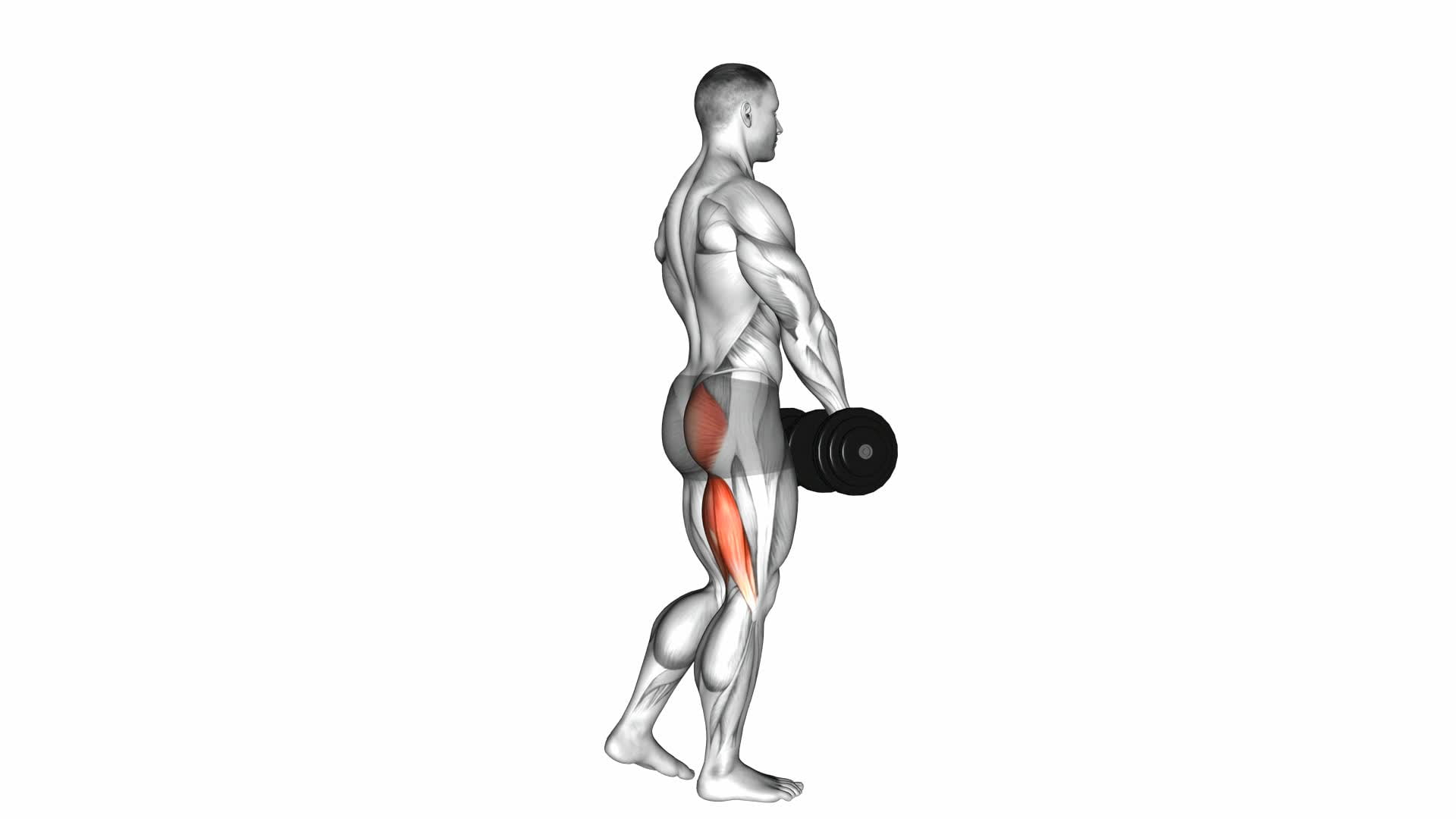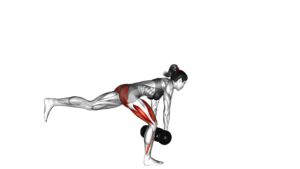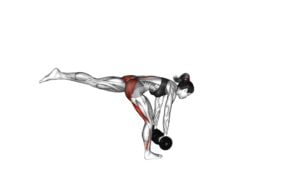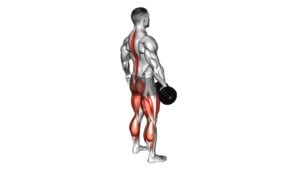Dumbbell Single Leg Deadlift – Video Exercise Guide & Tips

Are you looking to strengthen your legs and improve your balance? Look no further than the dumbbell single leg deadlift! This exercise targets your glutes, hamstrings, and core while challenging your stability.
Watch This Exercise Video
In this video exercise guide, you'll learn the proper form and technique, as well as variations and progressions to keep you challenged. Avoid common mistakes and get the most out of your workouts with these helpful tips.
Get ready to take your fitness to the next level!
Key Takeaways
- Strengthens core and improves balance
- Activates multiple muscles in the body
- Targets glutes, hamstrings, quadriceps, and calves
- Enhances proprioception and balance
Benefits of the Dumbbell Single Leg Deadlift
One major benefit of the Dumbbell Single Leg Deadlift is that it strengthens your core and improves balance. This exercise is highly effective in preventing injuries and activating multiple muscles in your body. The Dumbbell Single Leg Deadlift targets your glutes, hamstrings, quadriceps, and calves, making it a great exercise for overall lower body strength. By engaging your core muscles throughout the movement, you also develop a strong and stable core, which plays a crucial role in injury prevention.
During the Dumbbell Single Leg Deadlift, your muscles are activated in a unique way. As you lift one leg off the ground and hinge forward, your hamstrings work hard to control the movement and stabilize your body. This activation not only helps in building strength but also enhances your proprioception and balance. By training on one leg, you challenge your body to maintain stability and control, which can translate into improved performance in sports and everyday activities.
Proper form and technique are crucial when performing the Dumbbell Single Leg Deadlift to maximize its benefits and reduce the risk of injury. Therefore, it's essential to maintain a neutral spine, engage your core, and keep your hips level throughout the movement. Additionally, focus on hinging at the hips and keeping your back straight while lowering the dumbbell towards the ground. By following these guidelines, you can ensure that you're getting the most out of this exercise while minimizing the risk of injury.
Proper Form and Technique
To perform the Dumbbell Single Leg Deadlift with proper form and technique, focus on maintaining a neutral spine, engaging your core, and keeping your hips level throughout the movement. This exercise targets your hamstrings, glutes, and core, and can help improve your balance and stability.
Here are some key tips to ensure you execute this exercise correctly:
- Begin by standing tall with your feet hip-width apart and holding a dumbbell in each hand, palms facing your body.
- Shift your weight onto one leg and lift the other leg slightly off the ground, keeping it straight.
- Hinge forward at your hips, keeping your back straight and extending your free leg behind you for balance.
- Lower the dumbbells towards the ground while simultaneously raising your free leg until your torso and leg are parallel to the floor.
- Engage your glutes and hamstrings to raise your body back up to the starting position.
Common errors to watch out for include rounding your back, allowing your hips to rotate, and not engaging your core. To modify this exercise, you can perform it without weights or use a lower weight until you feel comfortable and confident with the movement.
With proper form and technique, you can maximize the benefits of the Dumbbell Single Leg Deadlift.
Now, let's explore some variations and progressions to challenge yourself even further.
Variations and Progressions
Try increasing the difficulty of the Dumbbell Single Leg Deadlift by incorporating these challenging variations.
Progressions and modifications can be made to enhance the effectiveness of this exercise and target different muscle groups.
One progression is to perform the exercise on an unstable surface, such as a Bosu ball or balance board. This challenges your balance and engages more muscles in your core and legs to stabilize your body.
Another progression is to increase the weight of the dumbbell or use two dumbbells simultaneously. This adds more resistance, making your muscles work harder.
You can also try performing the exercise with a longer range of motion by reaching the dumbbell towards the ground as you lower your torso, and then extending it overhead as you return to the starting position. This variation increases the challenge on your hamstrings, glutes, and lower back.
Lastly, you can incorporate a plyometric element by adding a jump at the top of the movement. This increases the power and explosiveness of the exercise, making it more challenging and effective.
Incorporating these progressions and modifications will help you continuously challenge yourself and achieve better results.
Common Mistakes to Avoid
Make sure to avoid these common mistakes when performing the Dumbbell Single Leg Deadlift. This exercise is highly effective for targeting the glutes, hamstrings, and core muscles, but it's important to maintain proper form to maximize results and prevent injury. Here are some technique tips to help you avoid common mistakes:
- Don't round your back: Keep your spine neutral throughout the entire movement. Avoid rounding your back as this can put strain on your lower back and increase the risk of injury. Engage your core muscles to maintain a stable and aligned spine.
- Don't rush the movement: Take your time and focus on maintaining control throughout the exercise. Avoid using momentum to lift the weight, as this can compromise your form and limit the effectiveness of the exercise. Slow and controlled movements ensure that the target muscles are properly engaged.
- Don't neglect balance and stability: The single leg deadlift requires good balance and stability. Make sure to distribute your weight evenly between the standing leg and the lifted leg. Engage your core and keep your hips level to maintain stability throughout the movement.
Tips for Maximizing Results
To maximize your results with the Dumbbell Single Leg Deadlift, focus on maintaining proper form and incorporating these tips into your workout routine.
One of the most important factors in maximizing intensity is to use a challenging weight for the exercise. Start with a weight that allows you to perform the exercise with good form, but also pushes you to your limits. As you progress, gradually increase the weight to continue challenging your muscles and stimulating growth.
Another tip for maximizing results is to focus on the mind-muscle connection. Really concentrate on engaging your glutes and hamstrings as you perform the exercise. This will help you to target those muscles more effectively and get the most out of each repetition.
In addition to these tips, there are also effective modifications you can incorporate to further maximize your results. One modification is to perform the exercise with a deficit. This means standing on a step or platform so that your working leg has a greater range of motion. This increases the challenge and helps to further develop strength and stability in your lower body.
Lastly, make sure to vary your foot position. Experiment with different foot positions such as a narrow stance, wide stance, or staggered stance. This will recruit different muscles and provide a more well-rounded workout.
Frequently Asked Questions
How Many Sets and Reps Should I Do When Performing the Dumbbell Single Leg Deadlift?
When performing the dumbbell single leg deadlift, you may be wondering how many sets and reps to do. Well, sets and reps depend on your fitness level and goals.
For beginners, start with 2-3 sets of 8-10 reps per leg. As you progress, increase the sets to 3-4 and reps to 10-12.
This exercise targets your hamstrings, glutes, and core, improving stability and balance. Don't forget to maintain proper form and gradually increase the weight for optimal results.
Can I Use a Barbell Instead of Dumbbells for This Exercise?
Yes, you can use a barbell instead of dumbbells for the single leg deadlift exercise. This is one of the alternatives to the dumbbell single leg deadlift.
Using a barbell allows you to lift heavier weights and engage more muscles in your lower body, including your hamstrings, glutes, and lower back. It also improves stability and balance.
Make sure to maintain proper form and start with lighter weights before progressing to heavier ones.
Is It Necessary to Warm up Before Doing the Dumbbell Single Leg Deadlift?
Before diving into the specifics of the dumbbell single leg deadlift, let's address the importance of warming up. Warming up before any exercise is crucial as it helps increase blood flow, loosen up your muscles, and prepare your body for the demands of the workout. It reduces the risk of injury and enhances performance.
As for modifications for beginners in the dumbbell single leg deadlift, start with lighter weights or no weights at all, and gradually increase as you gain strength and stability.
What Muscles Are Primarily Targeted During the Dumbbell Single Leg Deadlift?
During the dumbbell single leg deadlift, several muscles are primarily targeted. Your gluteus maximus, hamstrings, and erector spinae are heavily engaged to stabilize and control the movement.
Additionally, your quadriceps, calves, and core muscles are activated to maintain balance and stability.
The benefits of the dumbbell single leg deadlift include improved balance, increased strength and stability in the lower body, and enhanced hip mobility.
Can I Incorporate This Exercise Into My Leg Day Workout Routine?
Yes, you can definitely incorporate the dumbbell single leg deadlift into your leg day workout routine.
By adding this exercise, you'll reap the benefits of incorporating single leg exercises, such as improved balance, stability, and strengthening of the glutes, hamstrings, and lower back.
It also engages your core muscles for added stability during the movement.
Including this exercise will contribute to a well-rounded leg day routine and help you achieve your fitness goals.
Conclusion
In conclusion, the dumbbell single leg deadlift is a highly effective exercise for targeting the hamstrings, glutes, and core muscles.
By maintaining proper form and technique, you can maximize the benefits of this exercise and avoid common mistakes.
Additionally, incorporating variations and progressions can help challenge your muscles and promote further strength and stability.
Remember to follow these tips and guidelines to achieve optimal results from your dumbbell single leg deadlift routine.

Author
Years ago, the spark of my life’s passion ignited in my mind the moment I stepped into the local gym for the first time. The inaugural bead of perspiration, the initial endeavor, the very first surge of endorphins, and a sense of pride that washed over me post-workout marked the beginning of my deep-seated interest in strength sports, fitness, and sports nutrition. This very curiosity blossomed rapidly into a profound fascination, propelling me to earn a Master’s degree in Physical Education from the Academy of Physical Education in Krakow, followed by a Sports Manager diploma from the Jagiellonian University. My journey of growth led me to gain more specialized qualifications, such as being a certified personal trainer with a focus on sports dietetics, a lifeguard, and an instructor for wellness and corrective gymnastics. Theoretical knowledge paired seamlessly with practical experience, reinforcing my belief that the transformation of individuals under my guidance was also a reflection of my personal growth. This belief holds true even today. Each day, I strive to push the boundaries and explore new realms. These realms gently elevate me to greater heights. The unique combination of passion for my field and the continuous quest for growth fuels my drive to break new ground.







